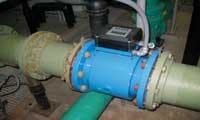Accurate Flow Metering Improves Efficiency, Lowers Costs
Operating a municipal water treatment plant can be quite a headache if you cannot rely on the accuracy of the plant’s flowmeters. Erroneous measurements created a good deal of frustration at the Boothbay Region Water District on the coast of Maine. Precision is vital as the district serve 3,000 customers year round as well as a greater population during the summer tourist season.
“We lacked confidence in our venturi flowmeters because our empirical readings did not match our theoretical calculations,” said Jon Ziegra, the plant manager of the Boothbay Region Water District. “In addition, the measured volume of water flowing into the plant did not correlate with the measurements of the plant’s output.”
The inaccuracy of the existing flowmeters was primarily due to fouling caused by the high hardness and the high iron and organic content of the source water, as well as the floc generated during the treatment process. The mechanical components of the venturi flowmeters were prone to fouling, even with frequent maintenance.
Expensive Overdosing
The plant adds aluminum sulfate to incoming raw water for a coagulation/flocculation process that removes dissolved natural organic matter. Without accurate metering, operators would overdose the alum to ensure that sufficient coagulation would occur to remove 99.99% of the total dissolved solids. A similar problem existed at the other end of the plant, where unreliable metering made it difficult to correctly dose fluoride.
“Without accurate flowmeter measurements, we were injecting more alum and other chemicals than required, which meant that we had to pass on this added expense to our customers,” Ziegra said.
Faulty metering also caused problems when backwashing the sand filters. Accurate flow metering is needed to pace the flow during backwash to ensure that the filter settles down in the correct position, in order to maintain performance and extend filter life.
New Flowmeters
In 2003, the Boothbay Region Water District replaced the poorly performing meters with Aquaflux electromagnetic flowmeters manufactured by Krohne.
“We chose the Aquaflux flowmeter because the accuracy and reliability of electromagnetic technology is well-established. And with no mechanical parts, the system is maintenance-free,” Ziegra said.
This absence of mechanical parts also means that there is no added pressure drop.
The electromagnetic flowmeter is suited for measuring the volumetric flow rate of electrically conductive liquids in water, wastewater and environmental engineering applications. It has a fully welded housing and a tight footprint. Providing accuracy and durability in various applications, the meters offer good linear quality and design, and are resistant to chemicals, corrosion and abrasion.
The Aquaflux meters range in sizes from 1" to 120" (or DN 25 to DN 3000). The Boothbay Region Water District selected the Krohne IFC 010 electromagnetic flow converter. The converter offers lower power consumption and features digital signal processing and a high-speed signal conversion system. The signal converter has a measuring error of less than 0.5 % of the measured value and a self-monitoring feature to rule out errors in operation.
The plant also chose to equip the flowmeters with Hastelloy “C” electrodes and hard rubber liners that comply with all NSF requirements for NSF/ANSI Certification Standard 61 - Drinking Water System Components - Health Effects, and is thus NSF approved for potable water service.
The district has installed an eight inch diameter meter to measure incoming water and a 12" diameter unit to measure the backwash process and to serve as the master meter for the distribution system. Currently, the distribution system uses two 8" Aquaflux flowmeters, and a third will be installed next year.
“The installation of the new Krohne flowmeters was easy, and the display and menus are user friendly,” Ziegra said. “The meters are extremely accurate and have required no maintenance. To achieve the high accuracy, we initially needed to address a few issues that required minor retrofits to the plant’s piping system.”
The electromagnetic meter’s readings were distorted by electrical interference resulting from chemical reactions of the chemicals used to adjust pH.
“We had been injecting acid and base solutions ahead of the meter, but this electrical interference problem was completely resolved simply by moving the chemical injection port six inches downstream past the meter.”
There was a minor issue with one of the two 12" meters used during the backwash operation. There was no problem with the meter positioned after a straight run of piping. But the other meter was installed after several twists and turns, and the readings drifted. The fix was easy and relatively inexpensive: a flow straightener was installed and both meters now perform equally well.
Precise Dosing
“Our operators are confident in our new flowmeters. The readings consistently match our theoretical calculations,” Ziegra said. “We are on an peninsula extending into the ocean, and our fresh water supply is quite limited. The state Department of Environmental Protection tightly regulates how much water we can draw from each of our reservoirs. With the new Krohne meters, we are confident that we are drawing no more, and no less, than our full allotment.
“Even more importantly, we are able to dose chemicals with more precision, without wasting additional chemicals to compensate for unreliable flowmeters. We use six different chemicals at various stages of the process and, therefore, the cost savings are significant.”
For more information about Krohne’s level and flow measurement products, visit the company’s website at www.krohne.com


